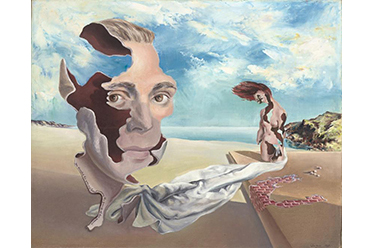 A provocative new National Gallery of Victoria (NGV) exhibition, Lurid Beauty: Australian Surrealism and its Echoes, will for the first time explore the Australian story of the 20th century’s most revolutionary art movement and its powerful influence on contemporary art and popular culture.
A provocative new National Gallery of Victoria (NGV) exhibition, Lurid Beauty: Australian Surrealism and its Echoes, will for the first time explore the Australian story of the 20th century’s most revolutionary art movement and its powerful influence on contemporary art and popular culture.
Radical and shocking, Surrealism shook up the Australian art world when it first reached our shores in the 1930s. Inspired by the psychological theories of Sigmund Freud, Surrealist artists sought to challenge artistic conventions, often exploring experimental and playful approaches designed to liberate the unconscious mind.
From the Dali-esque dreamscapes of James Gleeson to the hauntingly beautiful photographs of Max Dupain, Lurid Beauty will present more than 230 works traversing painting, drawing, collage, sculpture, fashion, film and photography. Iconic examples of Australian Surrealism by Albert Tucker, James Cant and Roy de Maistre will sit in dialogue with key Australian contemporary artists including Peter Ellis, Tim Schultz, Julie Rrap and Pat Brassington.
“It is inconceivable to imagine a world without Surrealism,” says Tony Ellwood, Director NGV. “The rich legacy of the movement is pervasive not only in contemporary art, but also film, theatre and even advertising, showing its continued influence upon modern society.”
The exhibition presents a thought-provoking approach to Australian Surrealism, highlighting the ongoing vitality and power of Surrealist thought. In a room devoted to collage and juxtaposition, works by Australia’s earliest collagists Sidney Nolan and Carl Plate can be seen alongside contemporary works by Zoë Croggon, Christopher Day and David Noonan.
In another gallery the magisterial late paintings of James Gleeson are hung adjacent to recent paintings by artists Tim Schultz and Peter Daverington. The concept of dreams is explored through the historical work of Clifford Bayliss and in Rosslynd Piggott’s 1998 installation High bed – featuring a towering four metre-tall bed.
The work of contemporary female artists will be placed in juxtaposition with the often misogynistic imagery of historical Surrealist works, challenging the strict gender roles of Freud’s psychoanalysis. Pat Brassington’s uncanny images of disembodied female torsos and open-mouthed pink lips reclaim ideas of the female body while Anne Wallace’s eerie Hitchcock-esque painting, Talking Cure, also challenges Freudian ideas by depicting a woman in therapy talking to an empty chair – removing the ‘typical’ Freud-like doctor and his diagnosis.
The exhibition will also highlight the influence of Surrealism on popular culture in the mediums of performance, film and fashion through works including Leigh Bowery’s debauched and flamboyant films – featuring a chainsaw-wielding nude and Bowery as a perverted teapot – which explore the Surrealist concept of irrationality.
Fashion collective Centre for Style will test the limits of wearable fashion with a tongue-in-cheek installation that questions the functionality of clothes with an array of avant-garde apparel, including dresses with impractical, warped silhouettes displayed on tormented wire mannequins.
The exhibition is accompanied by a richly-illustrated publication which features texts by artists including James Gleeson, Peter Ellis, Rosslynd Piggott, Barry Humphries and Tim Schultz, and a poem by Max Harris, alongside scholarly essays.
Lurid Beauty: Australian Surrealism and its Echoes
The Ian Potter Centre: NGV Australia, Federation Square, Melbourne
Exhibition: 9 October 2015 – 31 January 2016
Entry fees apply
For more information, visit: www.ngv.vic.gov.au for details.
Image: James Gleeson, We inhabit the corrosive littoral of habit 1940. oil on canvas 40.7 x 51.3 cm National Gallery of Victoria, Melbourne. Anonymous gift, 1941 © Courtesy of the artist
